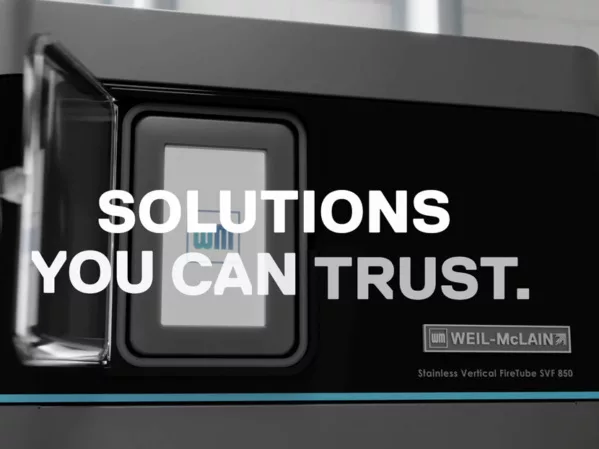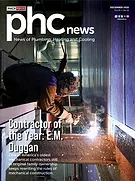Last August when we attended Watts Water Technologies’ 150th birthday, the company unveiled Nexa, its latest product that at the time was so new, Watts didn’t even have a press release to hand out.
Nexa is a water management solution for commercial buildings that offers real-time monitoring, alerts and insights to prevent water-related incidents and reduce water and energy consumption. The system features sensing technology and a software platform designed to uncover hidden water system insights and risks, allowing facility managers to enhance building performance and occupant experience.
This intelligent approach to water systems management is a frontrunner in providing an innovative approach by harnessing the power of smart technology to provide unprecedented control and efficiency. With this technology in place, all commercial water systems and the various equipment in the network are smartly connected and controlled. With real-time and historical performance metrics, guesswork is replaced with hard data.
We spoke recently with David Benaiges, vice president, Watts Digital, and Greg Berry, digital sales manager at Watts Water, to provide answers to several questions about this new and emerging technology.
We learned that with Nexa, many dangerous risks are minimized, including scalding, growth of legionella, and water leaks. Efficiency is optimized as facility managers or maintenance teams are armed with hard data for resource allocation and equipment performance. Even waste reduction is improved, enhancing a facility’s sustainability. Software advancements now address areas currently ignored by BMS, such as easier integration into any property, regardless of age, size, complexity and the equipment in its path.
PHCPPros: Nexa has been described as offering a “paradigm shift” for commercial plumbing systems. Why?
Benaiges: Consider the challenge: Maintaining optimal operation of commercial plumbing equipment typically involves responding to problems, forcing managers or technicians to react to an identified problem – perhaps a pipe blockage, pressure loss or a flooded mechanical room.
All too often, plumbing systems are functioning, yet problems are developing invisibly. Managers now have the ability to remotely monitor and control problems that are identified, and even challenges that aren’t yet fully-fledged. System sensors provide this awareness, offering insight and data. Another advantage is revealed as Nexa’s expert support team add eyes and hands to those on site, already on task, to understand and resolve issues.
Berry: Nexa replaces guesswork with data. Where skilled labor shortages are rampant, the software platform offers insights into an existing challenge, and developing challenges, too.
Inefficiencies and lack of control within plumbing systems invariably lead to water waste, increased costs and challenges in maintaining regulatory compliance. Intelligent water management – now a very real paradigm shift – addresses these issues head-on while offering a proactive, data-driven approach to improvements affecting many facets of commercial plumbing systems.
Benaiges: The paradigm shift is that facility plumbing systems – and all of the key components and equipment within them – now have the capability to communicate.
Rather than looking at symptoms, facility managers are empowered with predictive data – no longer reacting to a catastrophic flood in progress, but rather the ability to respond to – or even better – anticipate small leaks.
PHCPPros: What is “intelligent water management?”
Benaiges: It’s a holistic approach that involves monitoring, controlling and optimizing water use in commercial building ecosystems.
It encompasses the application of various technologies, including software, data analytics, automation systems and hardware including sensors and support to measure performance and recommend action. This approach is aimed at ensuring optimal, efficient and proactive use of water resources. A building’s plumbing and water systems include hydronic heating and cooling and wastewater as an “ecosystem” because that’s what it is: an unstable, vigorous system with many components and variables.
As a new, emerging application, commercial water management technology is an entirely new use of smart technology – in a field suffering from an intelligence “famine.” In many ways these new, dynamic solutions are like a shift from sketches on a napkin to sophisticated, 3D modeling.
Berry: The concept of quantifying and closely managing mechanical behavior isn’t new. We’ve seen the introduction of smart technology across many industries. It’s exciting to see this approach to data-driven operations take hold in commercial plumbing systems, an area that has historically been ignored, yet in dire need of innovation.
We are now moving beyond the tasks of individual components to onboard, embedded technologies playing key roles in equipment such as digital mixing systems or boilers – adding substantially to the value of intel available through BMS.
PHCPPros: How does all this smart technology come into play at a facility?
Benaiges: A user logs into Nexa and is greeted quickly by an intuitive dashboard. They check things like temperature, pressure and flow. The information comes from sensors that easily integrate into existing equipment. Or, in the case of a new system, the Nexa system and its components are hard at work from day one, sending real-time performance data to the dashboard.
It’s truly an answer to a facility manager’s dream: offering awareness of minor issues before they’re major problems. The ability to respond to changing conditions ensures that systems are functioning properly, allowing the ability to prevent all types of challenges, especially safety hazards. The level of control is unprecedented, waste is reduced, and peace of mind is restored.
PHCPPros: Can you provide examples of how these measurements are possible?
Berry: There are devices that monitor flow rates, water use, pressure, temperature and leak detection – all offering tangible insights into the plumbing system’s condition. Here are some examples:
• IoT and smart sensors: The Internet of Things, coupled with smart sensors, enables real-time data collection and analysis. Devices monitor flow rates, pressure levels and water quality, providing design engineers and facility managers with valuable insights to optimize system performance. Leak detection sensors can identify potential issues before they escalate, helping to prevent costly repairs and minimize water loss.
• Advanced analytics: With the data collected from IoT devices, advanced analytics algorithms and machine learning techniques identify patterns and predict system behaviors. Engineers now make informed decisions about maintenance, system upgrades, and conservation measures. Predictive analytics can forecast demand fluctuations, enabling better resource allocation without compromising service quality.
• Smart water management: Sensors are placed where they provide the most valuable information, assuring 24/7/365 data and protection. After all, it’s rare that maintenance and service personnel are on site continuously. But, sensors are at work around the clock, and alerts can reach any number of personnel simultaneously. The technology facilitates remote management, enabling allied professionals to respond to issues or to adjust parameters without the need to be on site – an ability that significantly reduces downtime and improves operational efficiency.
• Automated control: New control systems can dynamically adjust valves, pumps and other equipment based on real-time data, optimizing water delivery across the network.
• Water conservation: By accurately monitoring water use and identifying leaks, the new systems facilitate significant reductions in water waste. Water consumption is measured against water use.
• Energy efficiency: Intelligent management reduces the energy required for water heating and distribution, contributing to lower operational costs and increased sustainability.
• Improved service reliability: Enhanced monitoring and predictive maintenance lead to fewer system failures, reducing interruptions and improving customer satisfaction.
• Resource management: With real-time data collection, facility managers and plumbing engineers can ensure that systems are operating as they should. Benefits will likely include, for example, reductions to the cost of insurance. Leak defense systems negate the threat of flooding. Most insurers see this as a very big step.
PHCPPros: Why are experts saying this technology is so important?
Benaiges: We believe that commercial water management software is essential for building protection. After all, the best type of disaster is one you avoid entirely. High on the list of challenges to avoid by facility owners/managers are downtime, lost revenue, insurance premium spikes or loss of insurance.
The goal is to protect and preserve buildings. Consider, too, the value to facility employees and staff: their quality of life is enhanced. Currently, the rate of turnover among facility managers is high; having an intelligent water management platform in place prevents the loss of knowledge and familiarity so valuable to facility health.
This technology has helped to transform and modernize the plumbing industry. As these technologies are leveraged, plumbing engineers and facility managers are not only capable of meeting current challenges, but also pave the way for a sustainable and efficient future.
Berry: What we’re seeing for the first time is a water management solution for buildings that offers real-time monitoring, alerts and insights to prevent water-related incidents and reduce water and energy consumption. The technology provides the ability to uncover hidden water system insights and risks, allowing building managers to enhance building performance and occupant experience.
When used in conjunction with Nexa-compatible equipment, such as water heaters, digital mixing valves or shutoff valves, facility managers receive more insights into their water systems. The technology – developed specifically for facility managers – is also nonproprietary. A wide variety of manufactured components are easily combined to work in concert. Sensors are easily installed on existing equipment – including boilers, water heaters and digital mixing valves – or integrated into new installations.
Nexa’s advanced sensing technology monitors water temperature, leaks, pressure, and flow rates at many points along distribution pathways. Real-time data is then transmitted to dashboard management platforms, providing a clear picture of a facility’s water performance.
PHCPPros: How does Nexa offer equipment-level insight and control?
Benaiges: Plumbing or hydronic equipment behavior isn’t easy to predict, making commercial water management anything but simple. Though, with this new technology, managers receive access to track equipment behavior over time.
A facility manager assigns system access and initiates automatic alerts or notifications to service technicians, a manufacturers’ rep or independent contractors. System performance data is accessible on mobile devices, providing insight into developing challenges at the earliest sign of trouble, allowing them to be addressed swiftly. l






